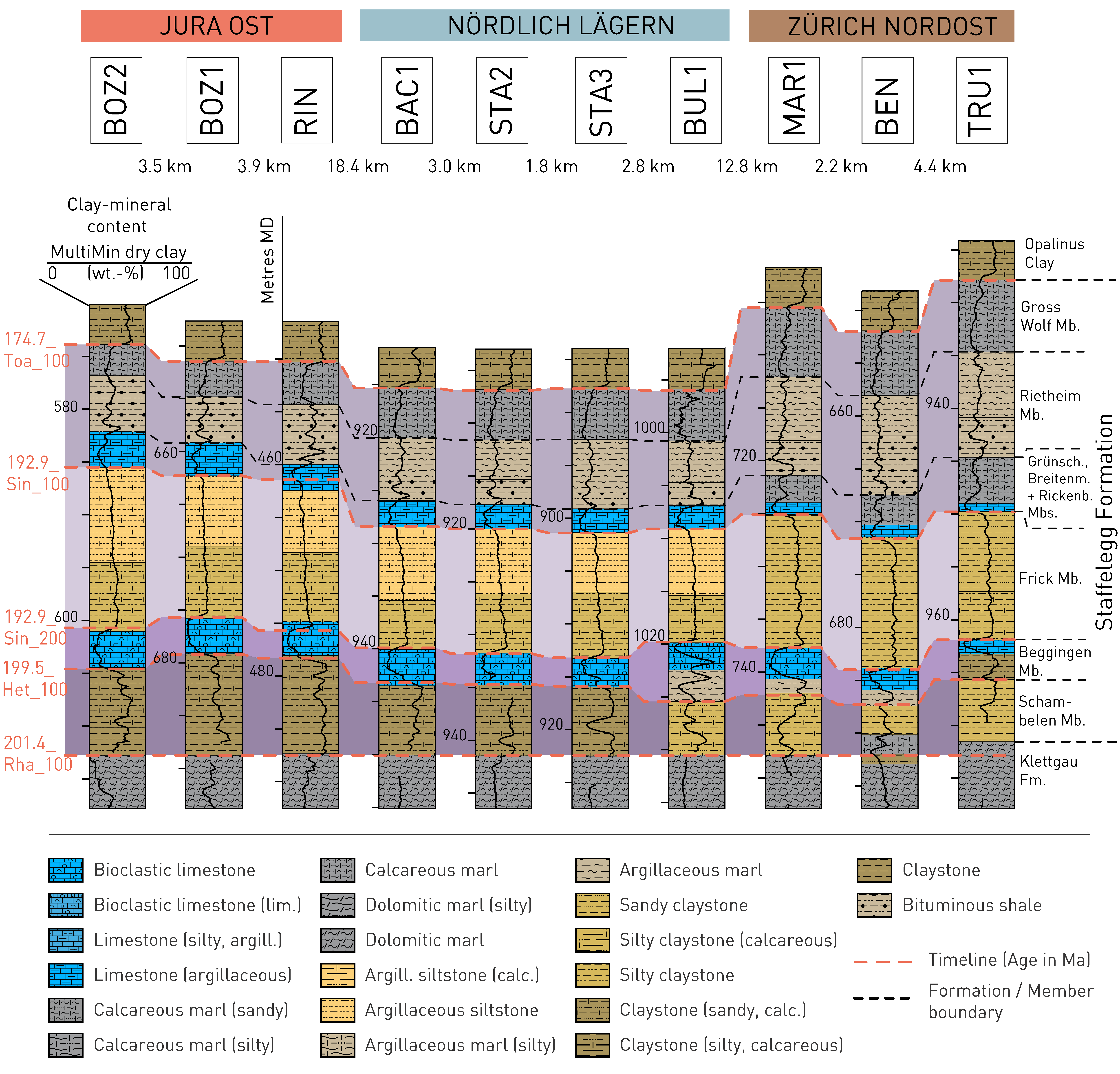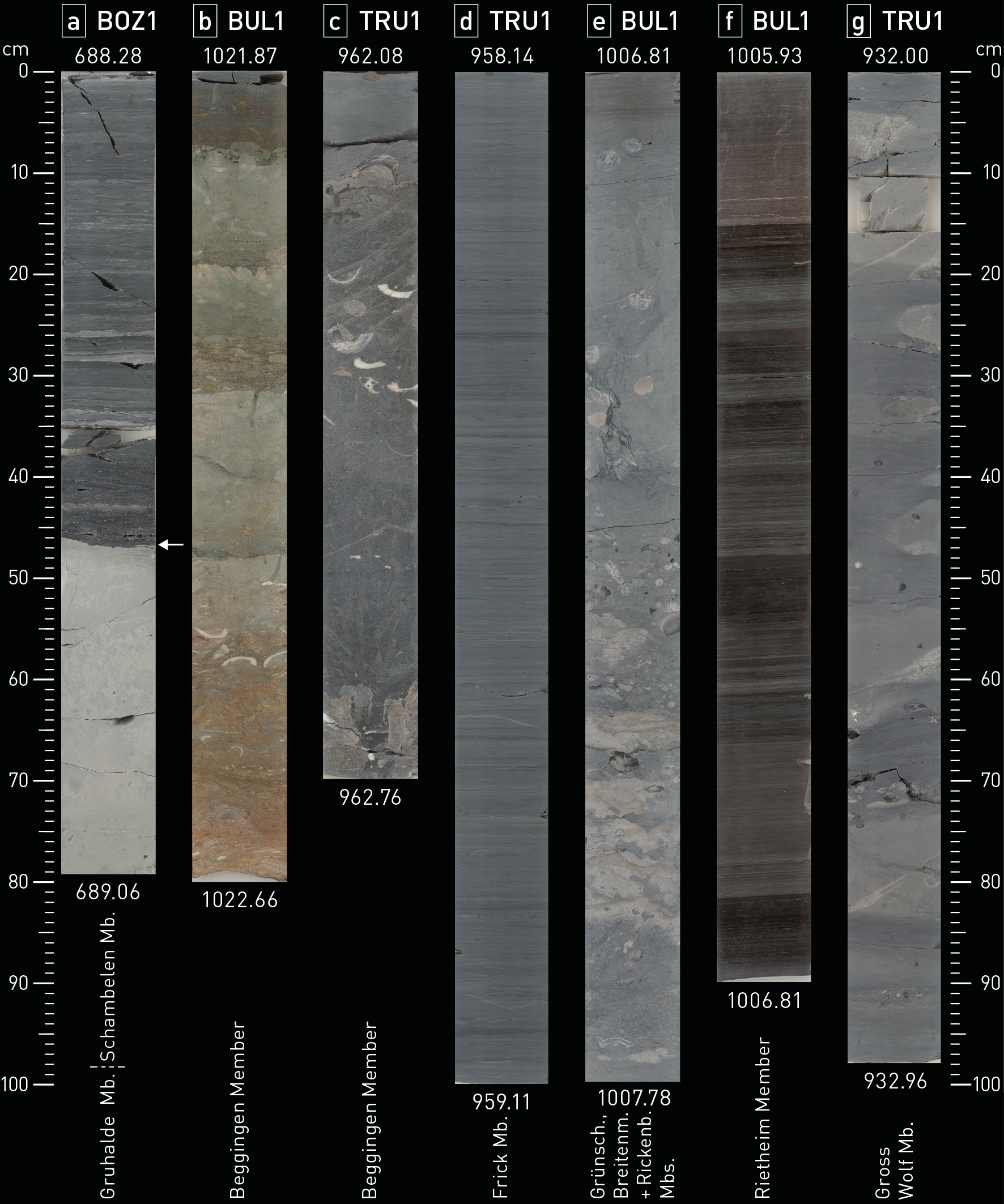The Staffelegg Formation exists in all the siting regions, with generally similar characteristics and a thickness that reaches 35 to 45 m (Fig. 4‑22). It consists mostly of claystone, siltstone and marl (Fig. 4‑23), but it also comprises limestone and iron-oolite (Fig. 4‑24). The Staffelegg Formation can be separated into eight members in the three siting regions (Reisdorf et al. 2011, Kiefer et al. 2015):
Schambelen Member (former «Insektenmergel», «Psiloceras-Schichten»): The lowermost unit of the Staffelegg Formation is the Schambelen Member (Fig. 4‑24a). Its thickness varies between ca. 5 and 10 m. It is dominated by sandy/silty claystone (partly bituminous) and siltstone, also fossiliferous marl (mainly bivalves) occurs. These strata are intercalated with dm-thick limestone beds, partly in the form of hardgrounds.
Beggingen Member (former «Arietenkalk» and «Angulatenschichten»): This unit has a thickness of ca. 3 to 4 m (Fig. 4‑26) and is dominated by fossiliferous limestone (partly iron-oolitic, limonitic and phosphatic) with interbeds of claystone and argillaceous marl (Fig. 4‑24b & c). Various surfaces with borings and/or hardgrounds can be identified. In outcrops such as at the clay pit of Frick Gruhalde Fig. 4‑25) cross-bedded limestone occurs, which is generally bioturbated (Reisdorf et al. 2011). A lower limestone succession with iron-oolitic interbeds and an upper limestone succession with abundant ammonites and Gryphaea oysters separated by a clay-mineral-rich interval are generally expected. However, this succession is not equally well developed in all boreholes across the siting regions.
Frick Member (former «Obtusus-Ton»): This unit has a thickness between ca. 11 and 16 m and is characterised by monotonous argillaceous siltstone and silty claystone (Fig. 4‑24d); macrofossils are rare.
Grünschholz (former «Obliqua-Schichten»), Breitenmatt (former «Numismalis-Schichten») and Rickenbach Members (former «Amaltheen-Schichten») (from bottom to top): These three units represent highly condensed intervals (Fig. 4‑24e). They are often described as one informal stratigraphic unit, as the unambiguous recognition of the three members is difficult. In some boreholes the lowermost Grünschholz Member was identified based on the presence of Gryphaea obliqua and its nodular look. The three members reach a total thickness between ca. 2 and 5 m. They are characterised by a fossiliferous (predominantly belemnites) succession of limestone, calcareous and argillaceous marl (all glauconitic) with nodules of phosphorite, siderite and pyrite. Bored surfaces and/or hardgrounds are common.
Rietheim Member (former «Posidonienschiefer»): This unit has a thickness between ca. 4 and 10 m. Its lower part is characterised by laminated bituminous shale with fossiliferous horizons (e.g. bivalves) and distinct cm- to dm-scale, partly laminated and bituminous limestone beds (e.g. «Unterer Stein»; Fig. 4‑24f). The upper part is characterised by argillaceous to calcareous marl which is still rich in organic matter.
Gross Wolf Member (former «Jurensis-Mergel»): This unit has a thickness of ca. 3 to 7 m and is dominated by silty to sandy argillaceous to calcareous marl, and decimetre-scale nodular interbeds of fossiliferous limestone (mostly belemnites) (Fig. 4‑24g).
To the west and east of the three siting regions, more sandy intercalations occur in the Staffelegg Formation, such as in the Weissenstein and Herdern Members (Fig. 4‑26). These members were not identified in the boreholes within the siting regions.

Fig. 4‑23:Stratigraphic borehole correlation of the Staffelegg Formation
For lithological nomenclature refer to Naef et al. (2019). Clay-mineral content after Becker & Marnat (2024). Some of the boundaries and lithologies as discussed in the original reports were adjusted to integrate all presented borehole data.

Fig. 4‑24:Selected core photos of the Staffelegg Formation (slabbed cores)
(a) Triassic/Jurassic discontinuity with change from terrestrial, light grey, dolomitic marl to marine, dark claystone with silty layers; (b) grey to ochre brown limestone (iron-oolitic), fossiliferous with various bored hardgrounds; (c) grey bioclastic limestone (partly argillaceous), fossiliferous, phosphatic concretions and two hardgrounds (962.19 m and 962.67 m); (d) grey, laminated silty claystone (calcareous); (e) grey limestone (partly argillaceous), glauconitic, fossiliferous (belemnites), with several bored and phosphatic hardgrounds; (f) dark grey to black, laminated, bituminous shale with limestone bed at top («Unterer Stein»); (g) grey calcareous marl with intercalated nodular limestone (both fossiliferous).

